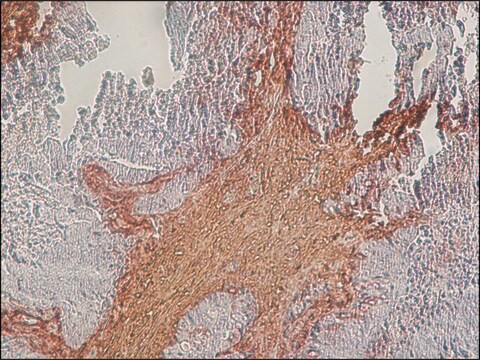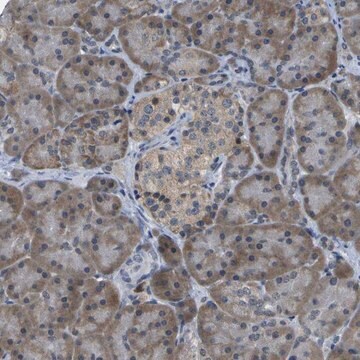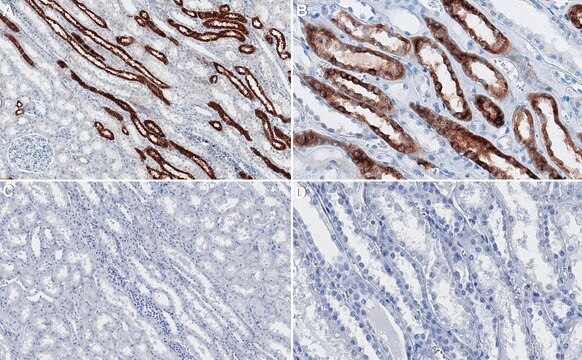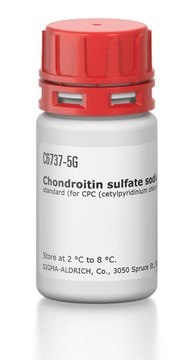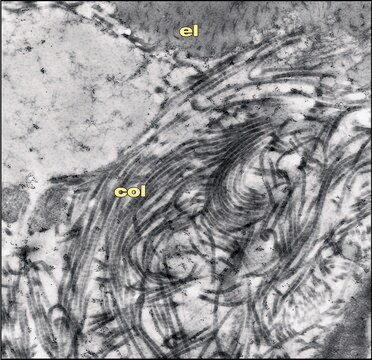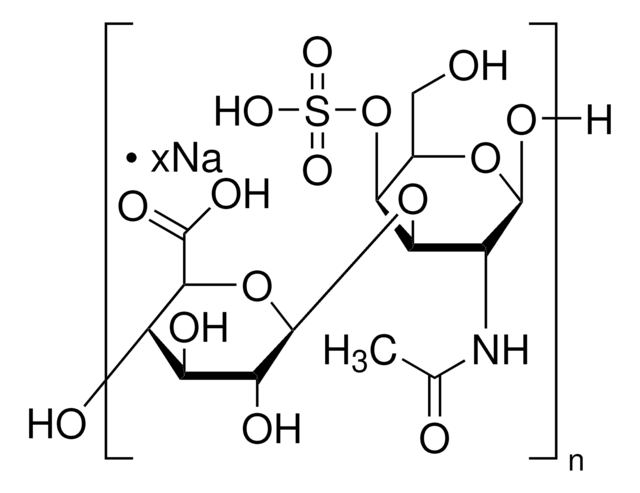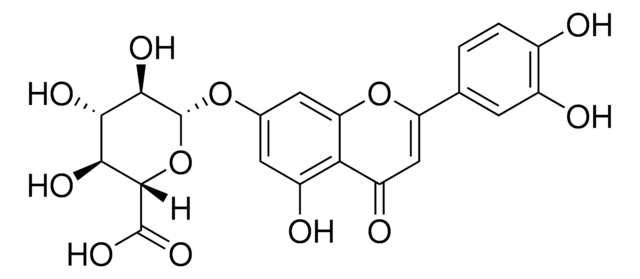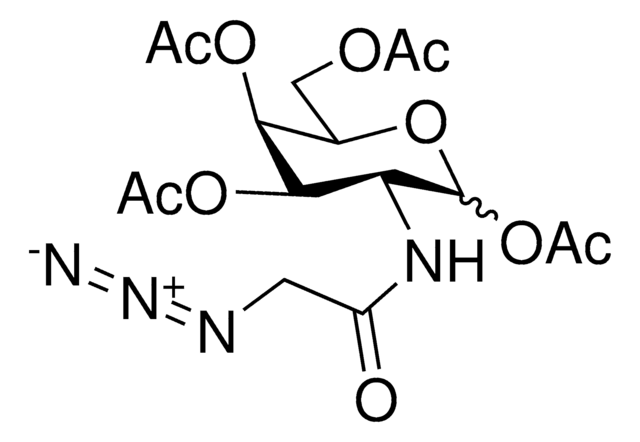추천 제품
생물학적 소스
mouse
Quality Level
항체 형태
purified antibody
항체 생산 유형
primary antibodies
클론
373E1, monoclonal
분자량
observed mol wt ~N/A kDa
정제법
affinity chromatography
종 반응성
chicken, human
종 반응성(상동성에 의해 예측)
vertebrates
포장
antibody small pack of 100
기술
ELISA: suitable
immunohistochemistry: suitable
immunoprecipitation (IP): suitable
western blot: suitable
동형
IgMκ
단백질 ID 수납 번호
UniProt 수납 번호
저장 온도
-10 to -25°C
특이성
Clone 373E1 is a mouse monoclonal antibody that detects Keratan sulfate in cartilage tissue.
면역원
Purified proteoglycans from embryonic chicken.
애플리케이션
Quality Control Testing
Evaluated by Immunohistochemistry (Paraffin) in Human cartilage tissue sections.
Immunohistochemistry (Paraffin) Analysis: A 1:50 dilution of this antibody detected Keratan Sulfate in human cartilage tissue sections.
Tested Applications
Western Blotting Analysis: A representative lot detected Keratan Sulfate in Western Blotting application (Magro, G., et al. (2003). Am J Pathol. 163(1):183-96).
Immunoprecipitation Analysis: A representative lot immunoprecipitated Keratan Sulfate in Immunoprecipitation application (Magro, G., et al. (2003). Am J Pathol. 163(1):183-96).
Immunohistochemistry Applications: A representative lot detected Keratan Sulfate in Immunohistochemistry application (Magro, G., et al. (2003). Am J Pathol. 163(1):183-96).
ELISA Analysis: A representative lot detected Keratan Sulfate in ELISA application (Magro, G., et al. (2003). Am J Pathol. 163(1):183-96).
Note: Actual optimal working dilutions must be determined by end user as specimens, and experimental conditions may vary with the end user.
Evaluated by Immunohistochemistry (Paraffin) in Human cartilage tissue sections.
Immunohistochemistry (Paraffin) Analysis: A 1:50 dilution of this antibody detected Keratan Sulfate in human cartilage tissue sections.
Tested Applications
Western Blotting Analysis: A representative lot detected Keratan Sulfate in Western Blotting application (Magro, G., et al. (2003). Am J Pathol. 163(1):183-96).
Immunoprecipitation Analysis: A representative lot immunoprecipitated Keratan Sulfate in Immunoprecipitation application (Magro, G., et al. (2003). Am J Pathol. 163(1):183-96).
Immunohistochemistry Applications: A representative lot detected Keratan Sulfate in Immunohistochemistry application (Magro, G., et al. (2003). Am J Pathol. 163(1):183-96).
ELISA Analysis: A representative lot detected Keratan Sulfate in ELISA application (Magro, G., et al. (2003). Am J Pathol. 163(1):183-96).
Note: Actual optimal working dilutions must be determined by end user as specimens, and experimental conditions may vary with the end user.
표적 설명
Keratan sulfate (also known as keratosulfate) is a widely distributed glycosaminoglycan in tensional and weight-bearing connective tissues, epithelial tissues, and the central and peripheral nervous system. It is attached to a number of proteoglycan and glycoprotein core proteins. Three types of keratan sulfate have been described: KS I, KS II, and KS III depending on their distribution pattern. Keratan sulfate is the only glycosaminoglycan (GAG) that does not contain uronic acid; therefore, it is not cleavable by the eliminative enzymatic cleavage. The biosynthesis of keratan sulfate occurs in two stages. In the first stage, the region binding the core protein with GAG is created followed by the elongation of the chain and its modification. The elongation of keratan sulfate chains of all types occurs by alternate attaching of Gal and GlcNAc residues, catalyzed by β-1,4-galactotransferase and β-1,3-N-acetyloglucosaminotransferase, respectively. Sulfation of keratan sulfate is carried out by at least two sulfotransferases. Gal 6-O-sulfotransferase transfers sulfate to position 6 of Gal residues located in the internal region of keratan sulfate and GlcNAc 6-O-sulfotransferase transfers sulfate to position 6 of GalNAc residues located at the nonreducing terminal of keratan sulfate. Clone 373E1 is a monoclonal antibody that detects a unique sialylation/ conformational-dependent KS epitope that detects a novel glycoprotein complex produced by papillary thyroid carcinoma cells. (Ref.: Magro, G., et al. (2003) Am. J. Pathol. 163(1); 183-196; Caterson, B., et al. (1982). J. Invest. Dermatol. 79 (suppl 1); 45-50; Coleman, PJ., et al. (1998). J. Physiol. 509(3); 695-710).
물리적 형태
Purified mouse monoclonal antibody IgM in PBS without preservatives.
재구성
1.0 mg/mL. Please refer to guidance on suggested starting dilutions and/or titers per application and sample type.
저장 및 안정성
Store at -10°C to -25°C. Handling Recommendations: Upon receipt and prior to removing the cap, centrifuge the vial and gently mix the solution. Aliquot into microcentrifuge tubes and store at -20°C. Avoid repeated freeze/thaw cycles, which may damage IgG and affect product performance.
기타 정보
Concentration: Please refer to the Certificate of Analysis for the lot-specific concentration.
면책조항
Unless otherwise stated in our catalog or other company documentation accompanying the product(s), our products are intended for research use only and are not to be used for any other purpose, which includes but is not limited to, unauthorized commercial uses, in vitro diagnostic uses, ex vivo or in vivo therapeutic uses or any type of consumption or application to humans or animals.
적합한 제품을 찾을 수 없으신가요?
당사의 제품 선택기 도구.을(를) 시도해 보세요.
Storage Class Code
12 - Non Combustible Liquids
WGK
WGK 2
Flash Point (°F)
Not applicable
Flash Point (°C)
Not applicable
시험 성적서(COA)
제품의 로트/배치 번호를 입력하여 시험 성적서(COA)을 검색하십시오. 로트 및 배치 번호는 제품 라벨에 있는 ‘로트’ 또는 ‘배치’라는 용어 뒤에서 찾을 수 있습니다.
자사의 과학자팀은 생명 과학, 재료 과학, 화학 합성, 크로마토그래피, 분석 및 기타 많은 영역을 포함한 모든 과학 분야에 경험이 있습니다..
고객지원팀으로 연락바랍니다.